Environmental Adaptation in the Process of Human-Land Relationship in Southeast China’s Ethnic Minority Areas and Its Significance on Sustainable Development
Abstract
:1. Introduction
2. Overview of the Study Area
3. Data and Methods
3.1. Data Sources
3.2. Research Methodology
3.2.1. Research Framework
3.2.2. Quadrat Analysis
3.2.3. Nearest Neighbor Index
3.2.4. Ripley’s K Function
3.2.5. Standard Deviational Ellipse
3.2.6. Kernel Density Estimation
4. Results
4.1. Distribution Characteristics of Toponyms
4.1.1. Word Frequency Distribution Characteristics
4.1.2. Spatial Distribution Pattern
4.2. Spatial Pattern Analysis
4.2.1. Results of Quadrat Square Analysis
4.2.2. Results of Nearest Neighbor Index
4.2.3. Scale Characteristics Reflected by Ripley’s K
4.3. Standard Deviation Ellipse Analysis Results
4.4. Kernel Density Estimation Results
5. Discussion
5.1. Influence Factors and Distribution of Settlements
5.2. Physical Geography and Settlements
5.2.1. Elevation Distribution Characteristics
5.2.2. Distribution Characteristics along the River
5.2.3. Topographic Features Indicated by Place Names
5.3. Environmental Adaptation and Sustainable Development Implications
6. Conclusions
Supplementary Materials
Author Contributions
Funding
Institutional Review Board Statement
Informed Consent Statement
Conflicts of Interest
References
- Zhu, S.; Kong, X.; Jiang, P. Identification of the human-land relationship involved in the urbanization of rural settlements in Wuhan city circle, China. J. Rural Stud. 2020, 77, 75–83. [Google Scholar] [CrossRef]
- Dong, G.; Zhang, W.; Xu, X.; Jia, K. Multi-Dimensional Feature Recognition and Policy Implications of Rural Human—Land Relationships in China. Land 2021, 10, 1086. [Google Scholar] [CrossRef]
- Chen, X.; Jiang, L.; Zhang, G.; Meng, L.; Pan, Z.; Lun, F.; An, P. Green-depressing cropping system: A referential land use practice for fallow to ensure a harmonious human-land relationship in the farming-pastoral ecotone of northern China. Land Use Policy 2021, 100, 104917. [Google Scholar] [CrossRef]
- Li, Y.; Kong, X.; Zhu, Z. Multiscale analysis of the correlation patterns between the urban population and construction land in China. Sustain. Cities Soc. 2020, 61, 102326. [Google Scholar] [CrossRef]
- Liu, X.; Zhang, Z.; Li, M.; Fu, Y.; Hui, Y. Spatial conflict simulation of land-use based on human-land-landscape elements intercoordination: A case study in Tianjin, China. Environ. Monit. Assess. 2022, 194, 1–17. [Google Scholar] [CrossRef]
- Jia, X.; Lee, H.F.; Cui, M.; Liu, C.; Zeng, L.; Yue, R.P.; Zhao, Y.; Lu, H. Habitat variability and ethnic diversity in Northern Tibetan Plateau. Sci. Rep.UK 2017, 7, 1–10. [Google Scholar] [CrossRef]
- Shen, Y.; Wang, D.; Wu, J.; Yu, T.; Li, T.; Li, S. Regional Features and Spatial Distribution of Fifty-Eight Ethnic Groups in Southwest China. Sustainability 2021, 13, 13570. [Google Scholar] [CrossRef]
- Chen, M.; Liang, L.; Wang, Z.; Zhang, W.; Yu, J.; Liang, Y. Geographical thoughts on the relationship between “Beautiful China” and land spatial planning. J. Geogr. Sci. 2020, 30, 705–723. [Google Scholar] [CrossRef]
- Hu, S.; Yu, B.; Luo, S.; Zhuo, R. Spatial pattern of the effects of human activities on the land surface of China and their spatial relationship with the natural environment. Environ. Dev. Sustain. 2022, 24, 10379–10401. [Google Scholar] [CrossRef]
- Plumwood, V. The concept of a cultural landscape: Nature, culture and agency in the land. Ethics Environ. 2006, 11, 115–150. [Google Scholar] [CrossRef]
- Rubenstein, J.M.; Healy, M. The Cultural Landscape: An Introduction to Human Geography; Pearson: Upper Saddle River Hoboken, NJ, USA, 2014; pp. 1–510. [Google Scholar]
- Von Haaren, C. Landscape planning facing the challenge of the development of cultural landscapes. Landsc. Urban Plan 2002, 60, 73–80. [Google Scholar] [CrossRef]
- Sandred, K.I. English stead: A Changeable Place Name Element in a Changing Community. Stud. Neophilol. 2001, 73, 164–170. [Google Scholar] [CrossRef]
- Gill, G. Changing Symbols: The Renovation of Moscow Place Names. Russ. Rev. 2005, 64, 480–503. [Google Scholar] [CrossRef]
- Cornelis, C.; Schoeters, G.; Kellen, E.; Buntinx, F.; Zeegers, M. Development of a GIS-based indicator for environmental pesticide exposure and its application to a Belgian case–control study on bladder cancer. Int. J. Hyg. Environ. Health 2009, 212, 172–185. [Google Scholar] [CrossRef] [PubMed]
- Mitchell, A. The ESRI Guide to GIS Analysis: Modeling Suitability, Movement, and Interaction; Esri Press: Redlands, CA, USA, 2012; Volume 3, pp. 1–109. [Google Scholar]
- Mei, Y. Encyclopedia of China: Geography; China Encyclopedia Press: Beijing, China, 1990; pp. 1–588. [Google Scholar]
- Guliang, C. The Spring and Autumn Annals; Liaoning Education Press: Shenyang, China, 1997; pp. 1–136. [Google Scholar]
- Light, D. Street names in Bucharest, 1990–1997: Exploring the modern historical geographies of post-socialist change. J. Hist. Geogr. 2004, 30, 154–172. [Google Scholar] [CrossRef]
- Fuchs, S. History and heritage of two Midwestern towns: A toponymic-material approach. J. Hist. Geogr. 2015, 48, 11–25. [Google Scholar] [CrossRef]
- Wang, F.; Wang, G.; Hartmann, J.; Luo, W. Sinification of Zhuang place names in Guangxi, China: A GIS—Based spatial analysis approach. Trans. Inst. Br. Geogr. 2012, 37, 317–333. [Google Scholar] [CrossRef]
- Tu, J.; Zhang, D. Does tourism promote economic growth in Chinese ethnic minority areas? A nonlinear perspective. J. Destin. Mark. Manag. 2020, 18, 100473. [Google Scholar] [CrossRef]
- Maurer-Fazio, M.; Hasmath, R. The contemporary ethnic minority in China: An introduction. Eurasian Geogr. Econ. 2015, 56, 1–7. [Google Scholar] [CrossRef]
- Guo, J.; Duan, Y.; Yang, F. Overview of Yunnan Ethnic Minorities; Yunnan People’s Publishing House: Kunming, China, 1999; pp. 1–78. [Google Scholar]
- Hasmath, R.; Ho, B. Job acquisition, retention, and outcomes for ethnic minorities in urban China. Eurasian Geogr. Econ. 2015, 56, 24–43. [Google Scholar] [CrossRef]
- Unwin, D.J. GIS, spatial analysis and spatial statistics. Prog. Hum. Geog. 1996, 20, 540–551. [Google Scholar] [CrossRef]
- Anselin, L.; Getis, A. Spatial statistical analysis and geographic information systems. Ann. Reg. Sci. 1992, 26, 19–33. [Google Scholar] [CrossRef]
- Cao, H. Urban—Rural income disparity and urbanization: What is the role of spatial distribution of ethnic groups? A case study of Xinjiang Uyghur Autonomous Region in western China. Reg. Stud. 2010, 44, 965–982. [Google Scholar] [CrossRef]
- Fraissinet, M.; Ancillotto, L.; Migliozzi, A.; Capasso, S.; Bosso, L.; Chamberlain, D.E.; Russo, D. Responses of avian assemblages to spatiotemporal landscape dynamics in urban ecosystems. Landscape Ecol. 2023, 38, 293–305. [Google Scholar] [CrossRef]
- Shi, L. History and Culture of She Nationality; Central University for Nationalities Press: Beijing, China, 1995; pp. 1–89. [Google Scholar]
- Xiong, D. Meteorological Annals of Jiangxi Province; Annals Press: Beijing, China, 1997; pp. 1–354. [Google Scholar]
- Wan, Q. Jiangxi Statistical Yearbook; China Statistics Press: Beijing, China, 2018. [Google Scholar]
- Yang, H. Compilation and Research of Jiangxi Local Records. Jiangxi Soc. Sci. 2000, 40, 72–76. [Google Scholar]
- Huang, L. Regional Geology of Jiangxi Province; Geological Publishing House: Beijing, China, 1984; pp. 1–921. [Google Scholar]
- Xie, J. Land Annals of Jiangxi Province; China Local Records Press: Beijing, China, 2003; pp. 1–78. [Google Scholar]
- Palleja, T.; Landers, A.J. Real time canopy density validation using ultrasonic envelope signals and point quadrat analysis. Comput. Electron. Agr. 2017, 134, 43–50. [Google Scholar] [CrossRef]
- McRee, R.K. Symbolic Regression Using Nearest Neighbor Indexing. In Proceedings of the 12th Annual Conference Companion on Genetic and Evolutionary Computation, New York, NY, USA, 7–11 July 2010; pp. 1983–1990. [Google Scholar]
- Kiskowski, M.A.; Hancock, J.F.; Kenworthy, A.K. On the use of Ripley’s K-function and its derivatives to analyze domain size. Biophys. J. 2009, 97, 1095–1103. [Google Scholar] [CrossRef]
- Ripley, B.D. Statistical Inference for Spatial Processes; Cambridge University Press: Cambridge, UK, 1988; pp. 1–48. [Google Scholar]
- Rahman, M.; Yang, R.; Di, L. Clustering Indian Ocean tropical cyclone tracks by the standard deviational ellipse. Climate 2018, 6, 39. [Google Scholar] [CrossRef]
- Yuill, R.S. The Standard Deviational Ellipse: An Updated Tool for Spatial Description. Geogr. Ann. 1971, 53, 28–39. [Google Scholar] [CrossRef]
- Chen, Y.C. A tutorial on kernel density estimation and recent advances. Biostat. Epidemiol. 2017, 1, 161–187. [Google Scholar] [CrossRef]
- Spencer, C.J.; Yakymchuk, C.; Ghaznavi, M. Visualising data distributions with kernel density estimation and reduced chi-squared statistic. Geosci. Front. 2017, 8, 1247–1252. [Google Scholar] [CrossRef]
- Bosso, L.; Smeraldo, S.; Russo, D.; Chiusano, M.L.; Bertorelle, G.; Johannesson, K.; Butlin, R.K.; Danovaro, R.; Raffini, F. The rise and fall of an alien: Why the successful colonizer Littorina saxatilis failed to invade the Mediterranean Sea. Biol. Invasions 2022, 24, 3169–3187. [Google Scholar] [CrossRef]
- Wang, H.G. Records of She Nationality in Yanshan; Local Records Publishing House: Beijing, China, 1999; pp. 1–441. [Google Scholar]
- Fang, Q.Y. Poverty Culture Phenomenon in Ethnic Towns: Taking Zhangping She Nationality Towns as an Example; China Publishing Group: Guangzhou, China, 2012; pp. 1–162. [Google Scholar]
- Wu, C.; Chen, M.; Zhou, L.; Liang, X.; Wang, W. Identifying the spatiotemporal patterns of traditional villages in China: A multiscale perspective. Land 2020, 9, 449. [Google Scholar] [CrossRef]
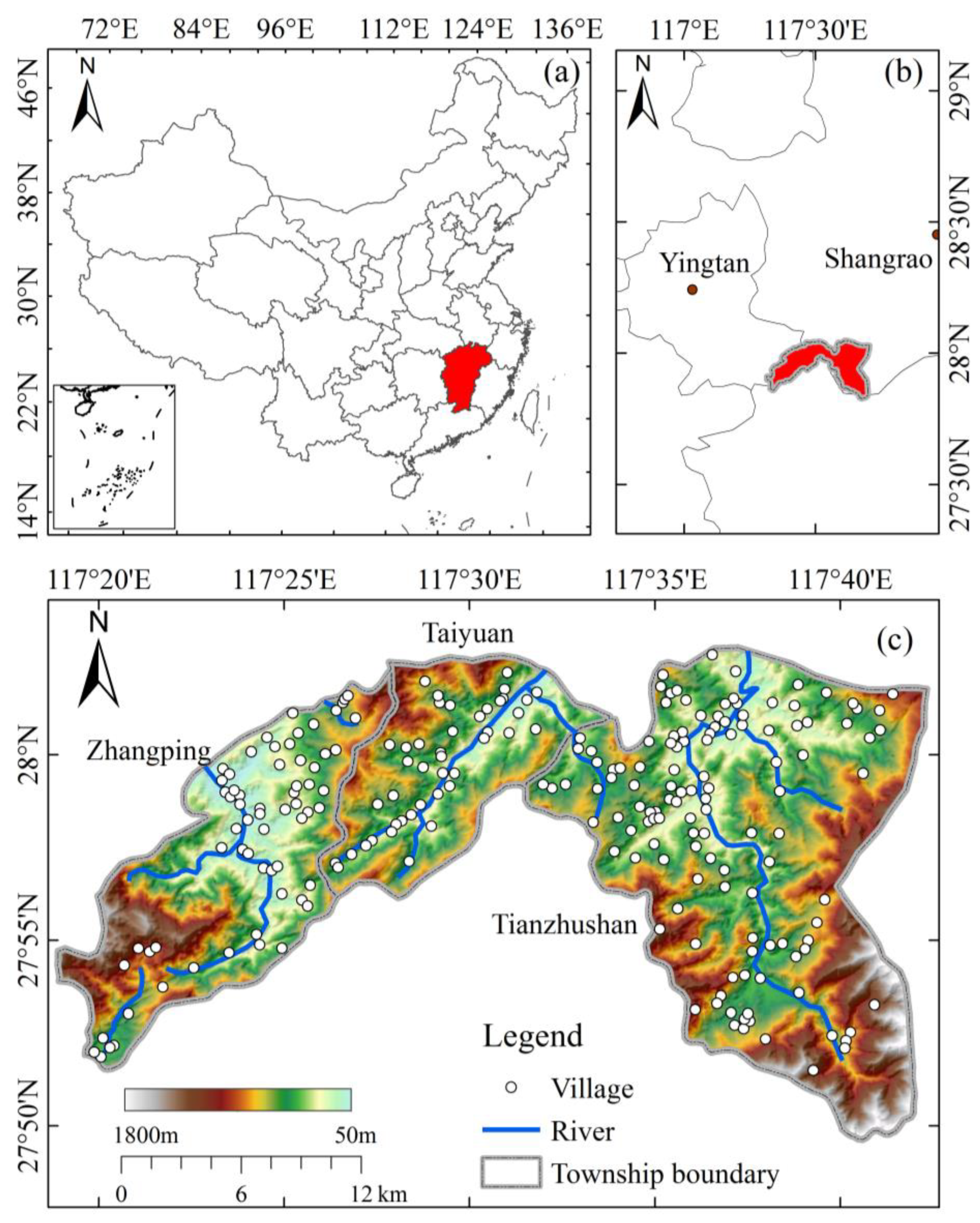
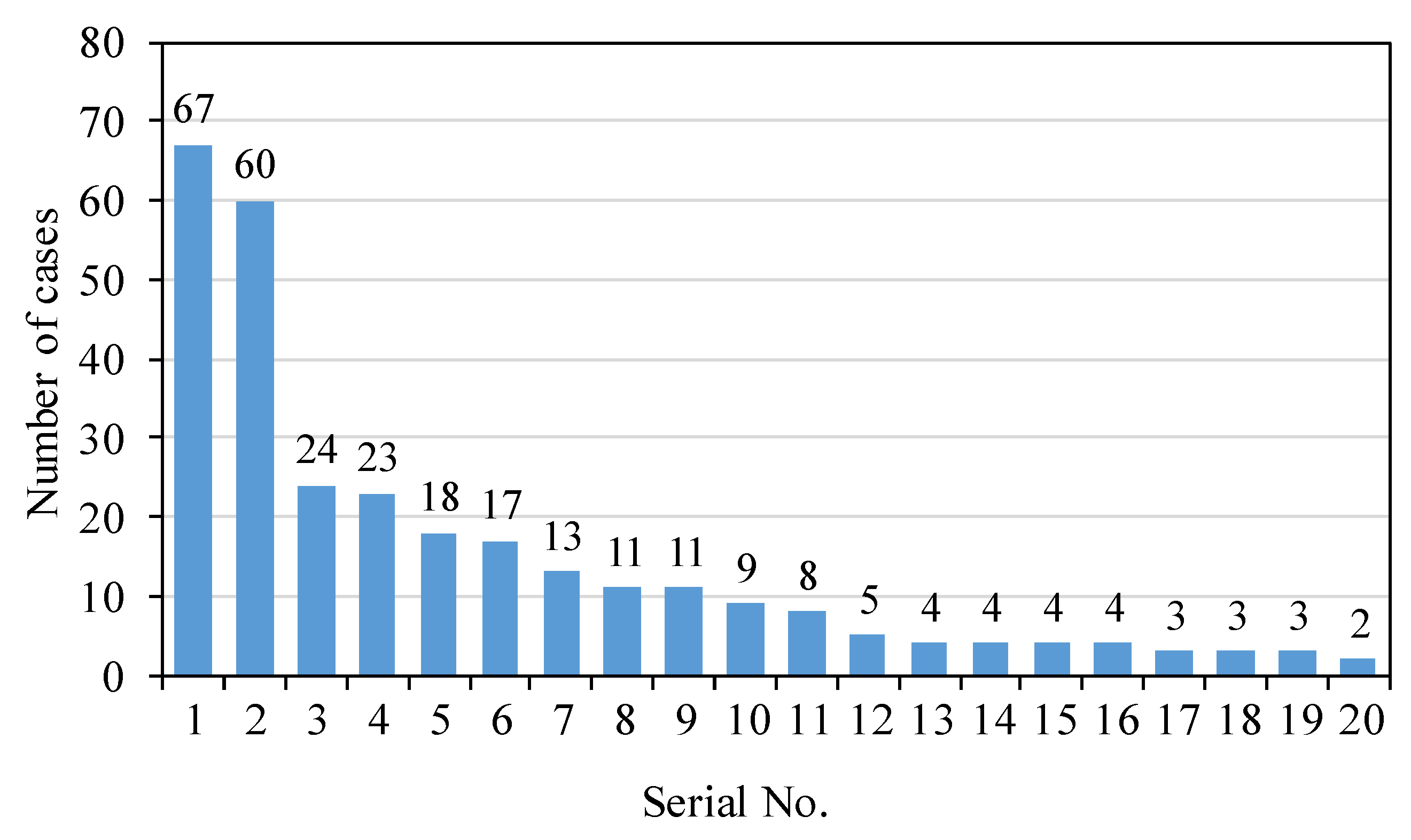
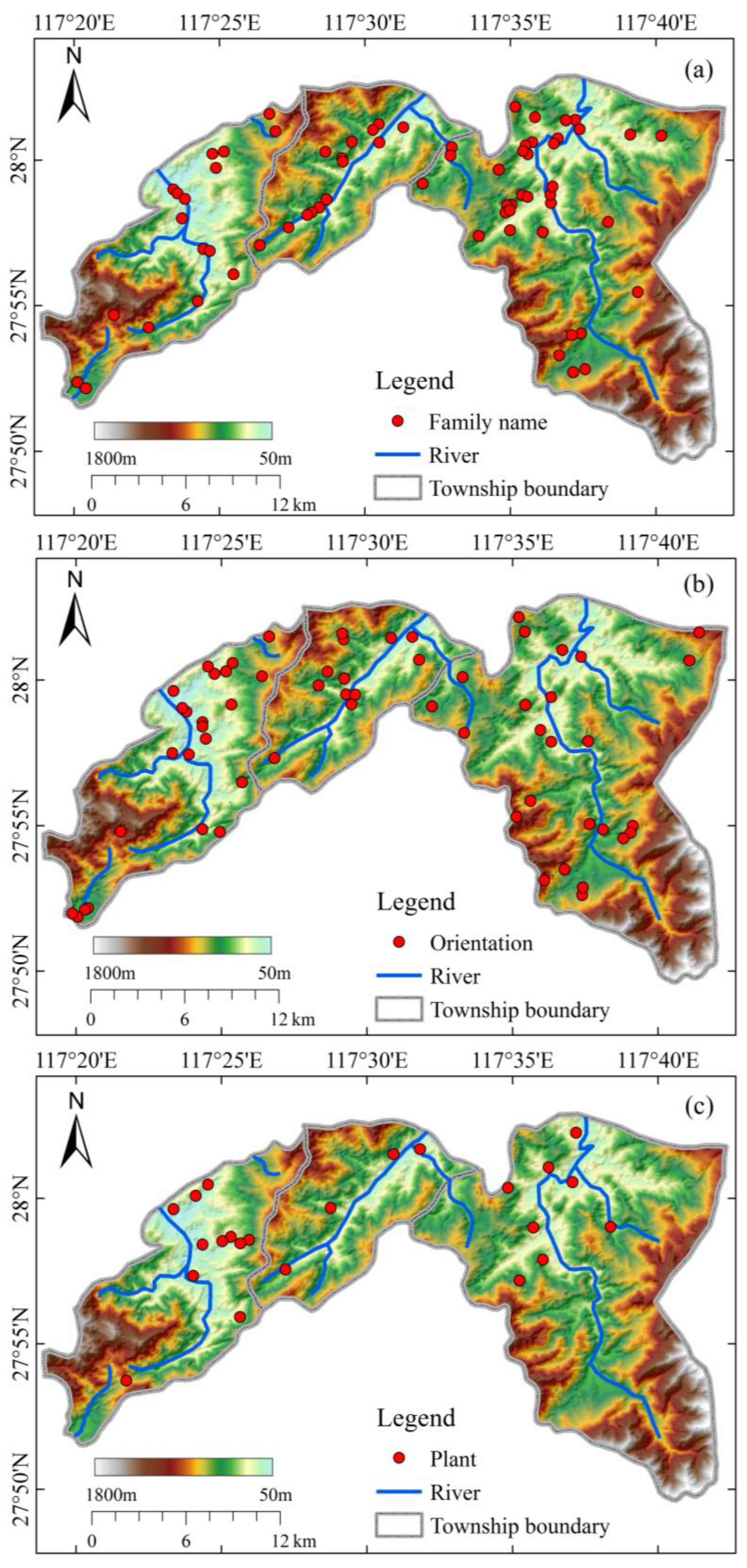
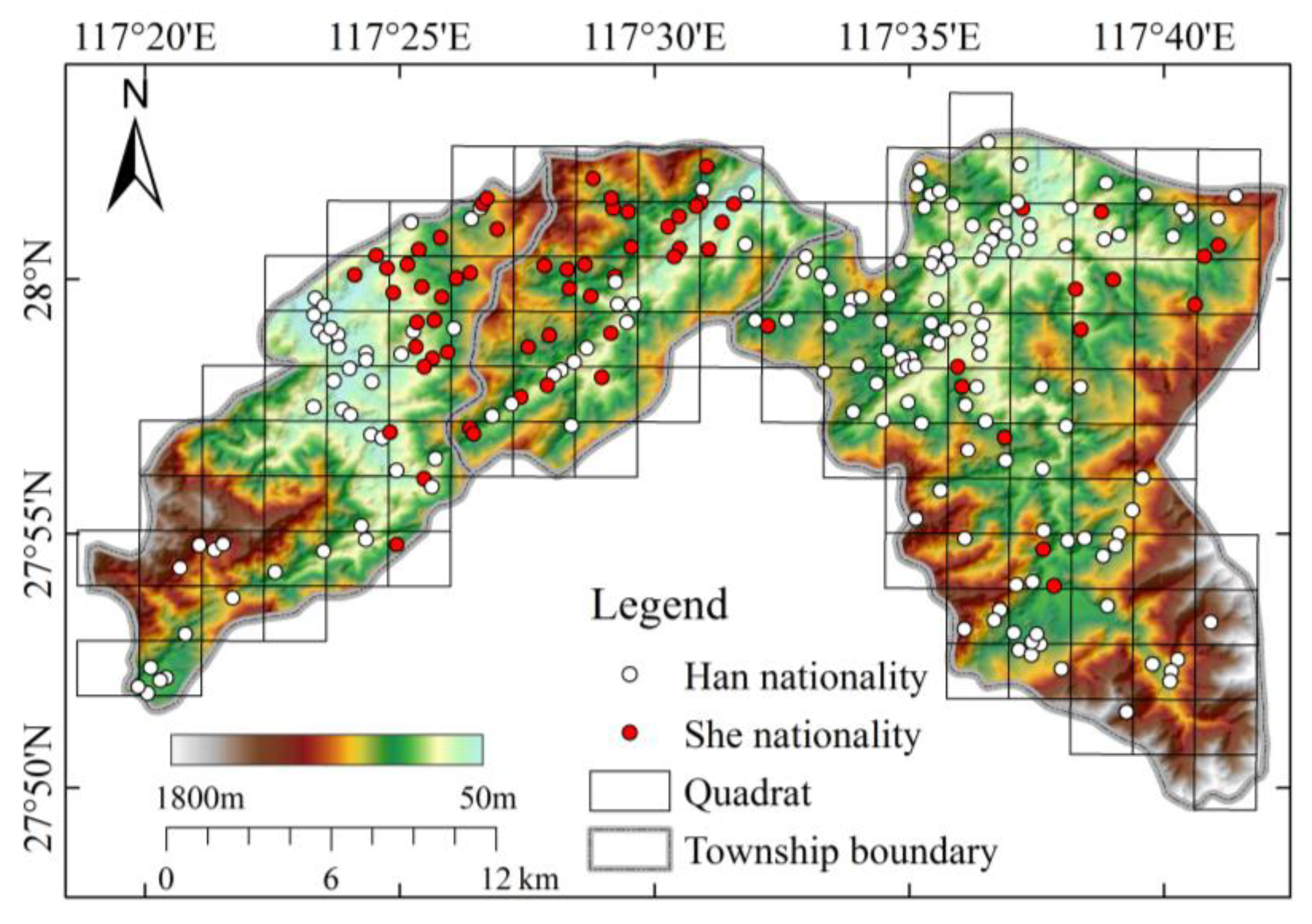
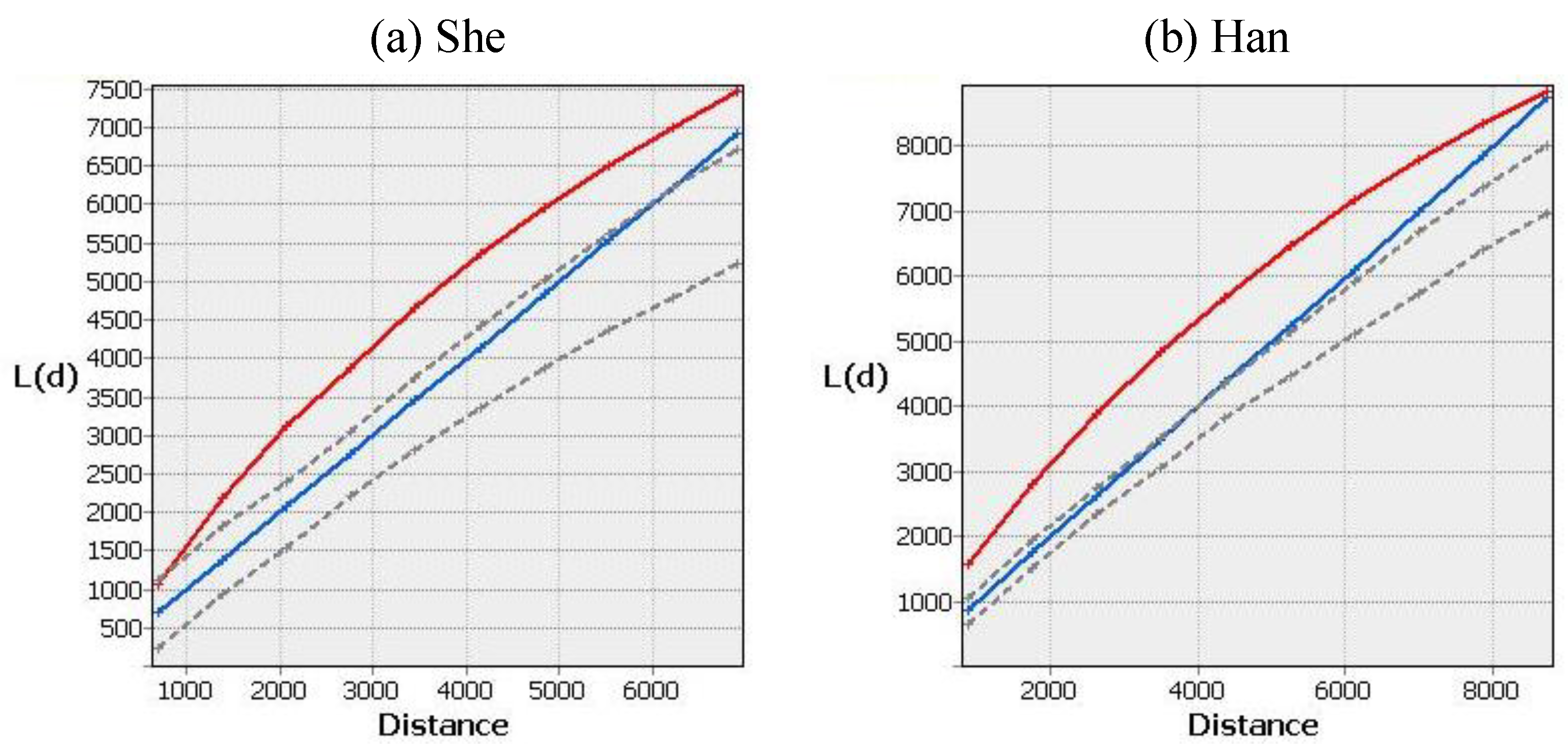
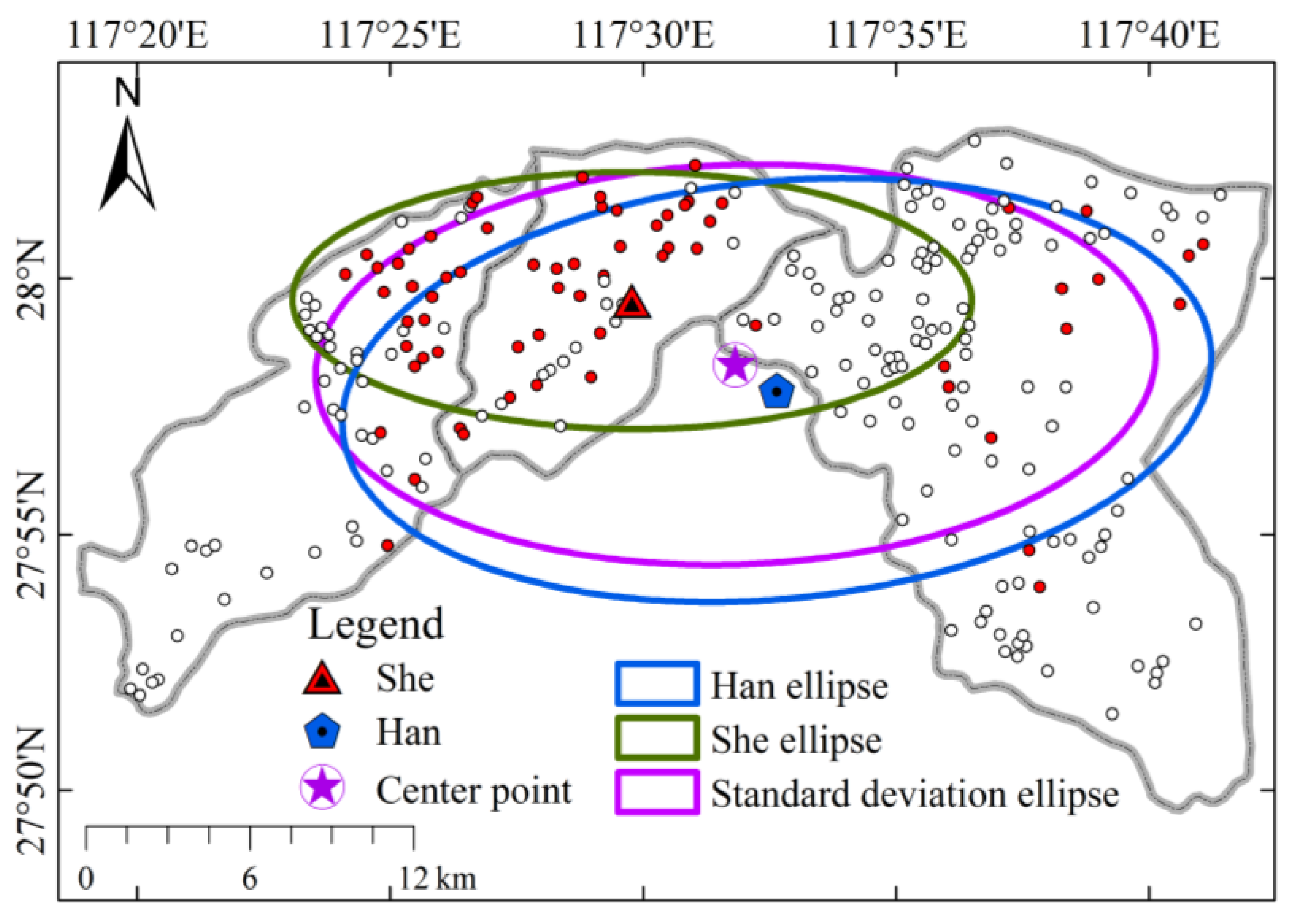

Disclaimer/Publisher’s Note: The statements, opinions and data contained in all publications are solely those of the individual author(s) and contributor(s) and not of MDPI and/or the editor(s). MDPI and/or the editor(s) disclaim responsibility for any injury to people or property resulting from any ideas, methods, instructions or products referred to in the content. |
© 2023 by the authors. Licensee MDPI, Basel, Switzerland. This article is an open access article distributed under the terms and conditions of the Creative Commons Attribution (CC BY) license (https://creativecommons.org/licenses/by/4.0/).
Share and Cite
Zhang, Z.; Wan, Z.; Xu, S.; Wu, H.; Liu, L.; Chen, Z.; Zeng, J. Environmental Adaptation in the Process of Human-Land Relationship in Southeast China’s Ethnic Minority Areas and Its Significance on Sustainable Development. Int. J. Environ. Res. Public Health 2023, 20, 2737. https://doi.org/10.3390/ijerph20032737
Zhang Z, Wan Z, Xu S, Wu H, Liu L, Chen Z, Zeng J. Environmental Adaptation in the Process of Human-Land Relationship in Southeast China’s Ethnic Minority Areas and Its Significance on Sustainable Development. International Journal of Environmental Research and Public Health. 2023; 20(3):2737. https://doi.org/10.3390/ijerph20032737
Chicago/Turabian StyleZhang, Zhi, Zhiwei Wan, Shan Xu, Hong Wu, Lingyue Liu, Zhao Chen, and Ji Zeng. 2023. "Environmental Adaptation in the Process of Human-Land Relationship in Southeast China’s Ethnic Minority Areas and Its Significance on Sustainable Development" International Journal of Environmental Research and Public Health 20, no. 3: 2737. https://doi.org/10.3390/ijerph20032737
APA StyleZhang, Z., Wan, Z., Xu, S., Wu, H., Liu, L., Chen, Z., & Zeng, J. (2023). Environmental Adaptation in the Process of Human-Land Relationship in Southeast China’s Ethnic Minority Areas and Its Significance on Sustainable Development. International Journal of Environmental Research and Public Health, 20(3), 2737. https://doi.org/10.3390/ijerph20032737






